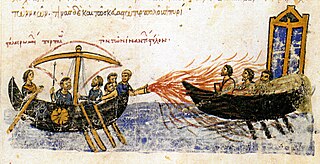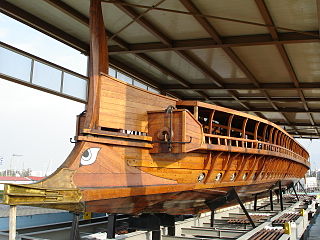 W
WThe Carracks black sword, sometimes called a crab sword, is a type of sword invented in Portugal, during the 15th century, designed to be used by soldiers and sailors in ships and caravels in the Age of Discovery.
 W
WThe corvus was a Roman naval boarding device used in sea battles against Carthage during the First Punic War.
 W
WA depth charge is an anti-submarine warfare (ASW) weapon. It is intended to destroy a submarine by being dropped into the water nearby and detonating, subjecting the target to a powerful and destructive hydraulic shock. Most depth charges use high explosive charges and a fuze set to detonate the charge, typically at a specific depth. Depth charges can be dropped by ships, patrol aircraft, and helicopters.
 W
WGreek fire was an incendiary weapon used by the Byzantine Empire beginning c. 672. Used to set fire to enemy ships, it consisted of a combustible compound emitted by a flame-throwing weapon. Some historians believe it could be ignited on contact with water, and was probably based on naphtha and quicklime. The Byzantines typically used it in naval battles to great effect, as it could supposedly continue burning while floating on water. The technological advantage it provided was responsible for many key Byzantine military victories, most notably the salvation of Constantinople from the first and second Arab sieges, thus securing the Empire's survival.
 W
WThe harpax or harpago was a Roman catapult-shot grapnel created by Marcus Vipsanius Agrippa for use against Sextus Pompey during the naval battles of the Sicilian revolt.
 W
WHMAS Sydney I - SMS Emden Memorial is a heritage-listed former foreign naval ship gun and now war memorial and war trophy located in Hyde Park, on the corner of Liverpool and College Streets in the Sydney central business district, in the City of Sydney local government area of New South Wales, Australia. It was designed by City of Sydney and built from 1917 by Messrs Loveridge and Hudson, Redfern. It is also known as HMAS Sydney 1 - SMS Emden Memorial and Emden Gun. The property is owned by City of Sydney. It was added to the New South Wales State Heritage Register on 27 February 2015.
 W
WA naval mine is a self-contained explosive device placed in water to damage or destroy surface ships or submarines. Unlike depth charges, mines are deposited and left to wait until they are triggered by the approach of, or contact with, any vessel. Naval mines can be used offensively, to hamper enemy shipping movements or lock vessels into a harbour; or defensively, to protect friendly vessels and create "safe" zones. Mines allow the minelaying force commander to concentrate warships or defensive assets in mine-free areas giving the adversary three choices: undertake an expensive and time-consuming minesweeping effort, accept the casualties of challenging the minefield, or use the unmined waters where the greatest concentration of enemy firepower will be encountered.
 W
WThe Bélier class, sometimes called the Cerbère class, was a class of four battleship rams built for the French Navy in the 1870s. Designed to have an offensive coast guard role, they rarely left their home port during their career and were the last of their type.
 W
WA ram was a weapon fitted to varied types of ships, dating back to antiquity. The weapon comprised an underwater prolongation of the bow of the ship to form an armoured beak, usually between 2 and 4 meters in length. This would be driven into the hull of an enemy ship to puncture, sink or disable the ship.
 W
WThe Reutech Rogue remote weapon system is a remotely controlled turret system for weapons ranging from 7.62 mm general purpose machine guns up to 20 mm cannons or a 40mm automatic grenade launcher. A version for anti-tank guided missiles has also been developed. There are versions for land and maritime use manufactured in South Africa by Reutech Solutions.
 W
WA submarine-launched missile is a missile that can be launched from a submarine. They include ballistic missiles (SLBMs) and cruise missiles (SLCMs). SLBMs are launched vertically; some other types are fired through the submarine's torpedo tubes.
 W
WA vertical launching system (VLS) is an advanced system for holding and firing missiles on mobile naval platforms, such as surface ships and submarines. Each vertical launch system consists of a number of cells, which can hold one or more missiles ready for firing. Typically, each cell can hold a number of different types of missiles, allowing the ship flexibility to load the best set for any given mission. Further, when new missiles are developed, they are typically fitted to the existing vertical launch systems of that nation, allowing existing ships to use new types of missiles without expensive rework. When the command is given, the missile flies straight up long enough to clear the cell and the ship, and then turns on course.